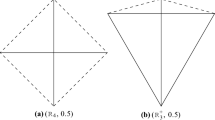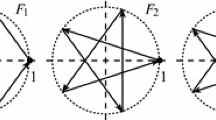Abstract
Let \(S\) be a set of \(2n\) points on a circle such that for each point \(p \in S\) also its antipodal (mirrored with respect to the circle center) point \(p'\) belongs to \(S\). A polygon \(P\) of size \(n\) is called antipodal if it consists of precisely one point of each antipodal pair \((p,p')\) of \(S\). We provide a complete characterization of antipodal polygons which maximize (minimize, respectively) the area among all antipodal polygons of \(S\). Based on this characterization, a simple linear time algorithm is presented for computing extremal antipodal polygons. Moreover, for the generalization of antipodal polygons to higher dimensions we show that a similar characterization does not exist.







Similar content being viewed by others
Notes
This property is not “if and only if” because there also exist non-thick polygons fulfilling the property.
References
Arkin, E., Dieckmann, C., Knauer, C., Mitchell, J., Polishchuk, V., Schlipf, L., Yang, S.: Convex transversals. Comput. Geom. 47(2), 224–239 (2014)
Arom, S., Thom, M., Tuckett, B., Boyd, R., Ligeti, G.: African Polyphony and Polyrhythm: Musical Structure and Methodology. Cambridge University Press, Cambridge (1991)
Audet, C., Hansen, P., Messine, F.: Extremal problems for convex polygons. J. Glob. Optim. 38, 163–179 (2007)
Boyce, J.E., Dobkin, D.P., Drysdale III, R.L., Guibas, L.J.: Finding extremal polygons. SIAM J. Comput. 14(1), 134–147 (1985)
Chemillier, M., Truchet, C.: Computation of words satisfying the“rhythmic oddity property” (after simha arom’s works). Inf. Process. Lett. 86(5), 255–261 (2003)
Díaz-Báñez, J.M., Farigu, G., Gómez, F., Rappaport, D., Toussaint., G.T.: El compás flamenco: a phylogenetic analysis. In: Proceedings of BRIDGES: Mathematical Connections in Art, Music and Science, pp. 61–70 (2004)
Díaz-Báñez, J.M., Korman, M., Pérez-Lantero, P., Pilz, A., Seara, C., Silvera, R.: New results on stabbing segments with a polygon. Comput. Geom. 48(1), 14–29 (2015)
Gale, D.: Neighboring vertices on a convex polyhedron. Linear inequalities and related system. In: Proceedings of Annals of Mathematics Studies, vol. 38, pp. 255–263. Princeton University Press, Princeton (1956)
Matoušek, J.: Using the Borsuk–Ulam theorem. Lectures on Topological Methods in Combinatorics and Geometry. Universitext. Springer, Berlin (2003)
Rappaport, D.: Maximal area sets and harmony. Gr. Comb. 23, 321–329 (2007)
Sadie, S., Grove,G.: The New Grove Dictionary of Music and Musicians. Macmillan; Grove’s Dictionaries of Music (1980)
Tóth, L.F.: On the sum of distances determined by a pointset. Acta Math. Acad. Sci. Hungar. 7, 397–401 (1956)
Toussaint, G.: Mathematical features for recognizing preference in sub-saharan african traditional rhythm timelines. In: Proceedings of Pattern Recognition and Data Mining, pp. 18–27. Springer, New York (2005)
Toussaint, G.: Computational geometric aspects of rhythm, melody, and voice-leading. Comput. Geom. Theory Appl. 43(1), 2–22 (2010)
Toussaint, G.T., Matthews, L., Campbell, M., Brown, N.: Measuring musical rhythm similarity: transformation versus feature-based methods. J. Interdiscip. Music Stud. 6, 23–53 (2012)
Acknowledgments
The problems studied here were introduced and partially solved during a visit to the University of La Havana, Cuba. We thank the project COFLA: Computational analysis of the Flamenco music (FEDER P09-TIC-4840 and FEDER P12-TIC-1362) for posing us the basic problem studied in this paper.
Author information
Authors and Affiliations
Corresponding author
Additional information
O. Aichholzer was partially supported by the ESF EUROCORES programme EuroGIGA - ComPoSe, Austrian Science Fund (FWF): I 648-N18. J.M.D.-B. was partially supported by projects FEDER P09-TIC-4840, P12-TIC-1362 (Junta de Andalucía), and by the ESF EUROCORES program EuroGIGA-ComPoSe IP04-MICINN Project EUI-EURC-201-4306. R. Fabila-Monroy was partially supported by Conacyt of Mexico, Grant 153984.
Rights and permissions
About this article
Cite this article
Aichholzer, O., Caraballo, L.E., Díaz-Báñez, J.M. et al. Characterization of Extremal Antipodal Polygons. Graphs and Combinatorics 31, 321–333 (2015). https://doi.org/10.1007/s00373-015-1548-z
Received:
Revised:
Published:
Issue Date:
DOI: https://doi.org/10.1007/s00373-015-1548-z




